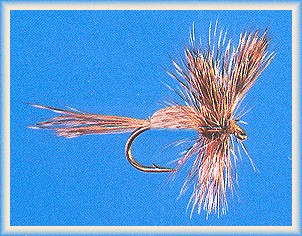Horner's Deer Hair
By Deanna Birkholm
Horner's Deer Hair is the origin of several fly patterns.
Jack Horner of San Francisco, CA, came up with this
method many years ago, it has been copied, with floss, thread
or chenille added for body color to match local conditions
nationwide. What makes the original so unique is using
the same material, a bunch of hair, to tie the whole fly
(not including the hackle.) Horner's Deer Hair fly has
no other body material, and works exceptionally well.
You can use the same method for a large variety of humpies
and the Goofus Bug.
Materials: Horner's Deer Hair
Hooks: TMC921 or DAI 1330, sizes 6-14
Thread: Black.
Tail: Coastal blacktail deer body hair.
Body: Coastal blacktail deer body hair (optional add
the colored floss or thread in here.)
Wings: The ends of the body material pulled up
and tied upright and divided.
Hackle: Grizzly. Wrap two turns behind and
two turns in front of the wing. Keep this hackle sparse
as this is what makes the fly effective.
Tying Steps:

1. Tie in the tail. Select hair which is hard and fine so you will have
less flare.

2. Return the thread to the front of the hook shank and tie in another
bunch of hair. This bunch of hair should be long enough to form an
underbody, overbody (shell) and the wings. Being able to determine the
correct length of hair will take some time and practice. (Optional, tie in
and cover the underbody with floss, tie off and trim.)

3. Pull the hair over the body and tie it down. Pull the remaining natural
hair tips upright and tie a divided wing.
|





